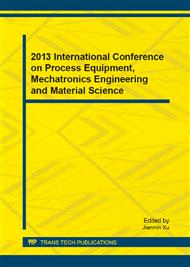[1]
Yun, W. S., Urban, J. J., Qian, G. & Park, H. Ferroelectric properties of individual barium titanate nanowires investigated by scanned probe microscopy. Nano. Lett. 2, 447-450 (2002).
DOI: 10.1021/nl015702g
Google Scholar
[2]
Naumov, I. I., Bellaiche, L. & Fu, H. Unusual phase transition in ferroelectric nanodisks and nanorods. Nature 432, 737-740 (2004).
DOI: 10.1038/nature03107
Google Scholar
[3]
Fu, H & Bellaiche, L. Ferroelectricity in barium titanate quantum dots and wires. Phys.Rev.Lett. 91, 257601 (2003).
DOI: 10.1103/physrevlett.91.257601
Google Scholar
[4]
Haun, M. J., Furman, E., Jang, S. J. & Cross, L. E. Thermodynamic theory of the lead zirconate-titanate solid solution system, part v: theoretical calculations. Ferroelectrics. 99, 63-86 (1989).
DOI: 10.1080/00150198908221440
Google Scholar
[5]
Park, S. E. & Shrout, T. R. Ultrahigh strain and piezoelectric behavior in relaxor based ferroelectric single crystal. J. Appl. Phys. 82, 1804-1811 (1997).
DOI: 10.1063/1.365983
Google Scholar
[6]
Unchino, K. Pieozelectric Actuators and Ultrasonic Motors (Kluwer Academic, Boston, 1996).
Google Scholar
[7]
Prosandeyev, S. A., Tarasevich, Y. Y. & Tesleenko, N. M. Lcao calculations of the electronic structure of PbTiO3 and PbZrO3. Ferroelectrics. 131, 137-140 (1992).
DOI: 10.1080/00150199208223404
Google Scholar
[8]
Cohen, R. E. & Karkauer, H. Electronic structure studies of the differences in ferroelectric behavior of BaTiO3 and PbTiO3. Ferroelectrics. 136, 65-83 (1992).
Google Scholar
[9]
Cohen, R. E. Origin of ferroelectricity in perovskite oxides. Nature 358, 136-138 (1992).
DOI: 10.1038/358136a0
Google Scholar
[10]
Fong, D. D. et al. Ferroelectricity in ultrathin perovskite film. Science 304, 1650-1653 (2004)
Google Scholar
[11]
Bellaiche, L. & Vanderbilt, D. Intrinsic piezoelectric response in perovskite alloys: PMN-PT versus PZT. Phys.Rev.Lett. 83, 1347-1350 (1999).
DOI: 10.1103/physrevlett.83.1347
Google Scholar
[12]
Graighead, H. G. Nanoelectromechanical systems. Science 290, 1532-1532 (2000)
Google Scholar
[13]
Polli, A. D., Lange, F. F. & Levi, C. G. Metastability of the fluorite, pyrochlore, and perovskite structure in the PbO-ZrO2-TiO2 system. J. Am. Ceram. Soc. 83, 873-881 (2000).
DOI: 10.1111/j.1151-2916.2000.tb01288.x
Google Scholar
[14]
Seifert, A., Lange, F. F. & Speck, J. S. Epitaxial growth of PbTiO3 thin film in (001) SrTiO3 from solution precursors. J. Mater. Res. 10, 680-691 (1995).
DOI: 10.1557/jmr.1995.0680
Google Scholar
[15]
Gotthard, S. S., Cohen, R. E. & Krakauer, H. First-principles study of piezoelectricity in PbTiO3. Phys.Rev.Lett. 80, 4321-4324 (1998).
Google Scholar


